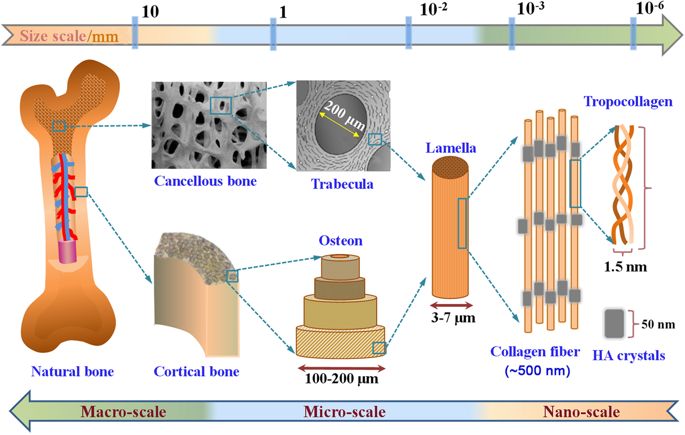Our official English website, www.x-mol.net, welcomes your
feedback! (Note: you will need to create a separate account there.)
Bone biomaterials and interactions with stem cells.
Bone Research ( IF 14.3 ) Pub Date : 2017-01-01 , DOI: 10.1038/boneres.2017.59 Chengde Gao 1 , Shuping Peng 2, 3 , Pei Feng 1 , Cijun Shuai 1, 4, 5
Bone Research ( IF 14.3 ) Pub Date : 2017-01-01 , DOI: 10.1038/boneres.2017.59 Chengde Gao 1 , Shuping Peng 2, 3 , Pei Feng 1 , Cijun Shuai 1, 4, 5
Affiliation

|
Bone biomaterials play a vital role in bone repair by providing the necessary substrate for cell adhesion, proliferation, and differentiation and by modulating cell activity and function. In past decades, extensive efforts have been devoted to developing bone biomaterials with a focus on the following issues: (1) developing ideal biomaterials with a combination of suitable biological and mechanical properties; (2) constructing a cell microenvironment with pores ranging in size from nanoscale to submicro- and microscale; and (3) inducing the oriented differentiation of stem cells for artificial-to-biological transformation. Here we present a comprehensive review of the state of the art of bone biomaterials and their interactions with stem cells. Typical bone biomaterials that have been developed, including bioactive ceramics, biodegradable polymers, and biodegradable metals, are reviewed, with an emphasis on their characteristics and applications. The necessary porous structure of bone biomaterials for the cell microenvironment is discussed, along with the corresponding fabrication methods. Additionally, the promising seed stem cells for bone repair are summarized, and their interaction mechanisms with bone biomaterials are discussed in detail. Special attention has been paid to the signaling pathways involved in the focal adhesion and osteogenic differentiation of stem cells on bone biomaterials. Finally, achievements regarding bone biomaterials are summarized, and future research directions are proposed.
中文翻译:

骨生物材料及其与干细胞的相互作用。
骨生物材料通过为细胞粘附、增殖和分化提供必要的基质以及调节细胞活性和功能,在骨修复中发挥着至关重要的作用。在过去的几十年里,人们致力于开发骨生物材料,重点关注以下问题:(1)开发具有合适的生物和机械性能的理想生物材料; (2)构建纳米级、亚微米级、微米级孔隙的细胞微环境; (3)诱导干细胞定向分化,进行人工向生物转化。在这里,我们对骨生物材料的最新技术及其与干细胞的相互作用进行了全面的回顾。综述了已开发的典型骨生物材料,包括生物活性陶瓷、可生物降解聚合物和可生物降解金属,重点介绍了它们的特性和应用。讨论了细胞微环境所需的骨生物材料的多孔结构以及相应的制造方法。此外,还总结了用于骨修复的有前景的种子干细胞,并详细讨论了它们与骨生物材料的相互作用机制。特别关注涉及干细胞在骨生物材料上的粘着斑和成骨分化的信号通路。最后,总结了骨生物材料的研究成果,并提出了未来的研究方向。
更新日期:2019-01-26
中文翻译:

骨生物材料及其与干细胞的相互作用。
骨生物材料通过为细胞粘附、增殖和分化提供必要的基质以及调节细胞活性和功能,在骨修复中发挥着至关重要的作用。在过去的几十年里,人们致力于开发骨生物材料,重点关注以下问题:(1)开发具有合适的生物和机械性能的理想生物材料; (2)构建纳米级、亚微米级、微米级孔隙的细胞微环境; (3)诱导干细胞定向分化,进行人工向生物转化。在这里,我们对骨生物材料的最新技术及其与干细胞的相互作用进行了全面的回顾。综述了已开发的典型骨生物材料,包括生物活性陶瓷、可生物降解聚合物和可生物降解金属,重点介绍了它们的特性和应用。讨论了细胞微环境所需的骨生物材料的多孔结构以及相应的制造方法。此外,还总结了用于骨修复的有前景的种子干细胞,并详细讨论了它们与骨生物材料的相互作用机制。特别关注涉及干细胞在骨生物材料上的粘着斑和成骨分化的信号通路。最后,总结了骨生物材料的研究成果,并提出了未来的研究方向。































 京公网安备 11010802027423号
京公网安备 11010802027423号